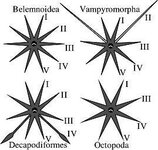- Joined
- Sep 26, 2005
- Messages
- 352
Just wondered, as a direct result of my uni-related cephy exploits, what on earth's the difference between an arm and a tentacle!?
I know all about squid having arms with rows of suckers, and tentacles with a club filled with suckers, and the carpal having very sparse arrangements-to-no suckers etc, and the tentacles are specialised for (usually) catching prey but I start getting confused when octopuses don't have tentacles, they have arms, meanwhile nautiluses don't have arms they have TENTACLES! And they're devoid of suckers! Instead they have adhesive ridges or something... so what acutally IS the difference between an arm and a tentacle?

Would it have something ot do with the amount of motor control? Are arms more dextrous than tentacles? I'm kinda lost now....
Graeme
I know all about squid having arms with rows of suckers, and tentacles with a club filled with suckers, and the carpal having very sparse arrangements-to-no suckers etc, and the tentacles are specialised for (usually) catching prey but I start getting confused when octopuses don't have tentacles, they have arms, meanwhile nautiluses don't have arms they have TENTACLES! And they're devoid of suckers! Instead they have adhesive ridges or something... so what acutally IS the difference between an arm and a tentacle?


Would it have something ot do with the amount of motor control? Are arms more dextrous than tentacles? I'm kinda lost now....

Graeme

